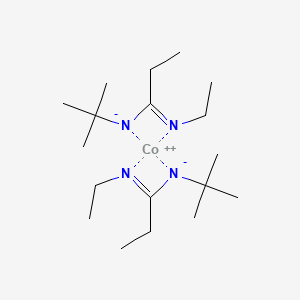Bis(N-t-butyl-N'-ethylpropanimidamidato)cobalt(II) | AMERICAN ELEMENTS® (original) (raw)
Chemical Structure
Question? Ask an American Elements Materials Science Engineer
| Compound Formula | C18H38CoN4 |
|---|---|
| Molecular Weight | 369.45 |
| Appearance | Blue-green liquid |
| Melting Point | N/A |
| Boiling Point | N/A |
| Density | N/A |
| Solubility in H2O | Not miscible or difficult to mix |
| Exact Mass | 369.242842 g/mol |
| Monoisotopic Mass | 369.242842 g/mol |
| Signal Word | Warning |
|---|---|
| Hazard Statements | H315+H320-H351-H335 |
| Hazard Codes | Xi, Xn |
| Precautionary Statements | P101-P102-P103-P231+P222-P305+P351+P338-P403+P233-P422-P501 |
| Risk Codes | N/A |
| Safety Statements | N/A |
| Transport Information | NONH for all modes of transport |
| GHS Pictogram | Image  , Image , Image  |
tert-butyl-(C,N-diethylcarbonimidoyl)azanide cobalt(2+)
| Linear Formula | C18H38CoN4 |
|---|---|
| Pubchem CID | 121237759 |
| MDL Number | MFCD29905430 |
| IUPAC Name | tert-butyl-(C,N-diethylcarbonimidoyl)azanide; cobalt(2+) |
| Beilstein/Reaxys No. | |
| SMILES | CCC(=NCC)[N-]C(C)(C)C.CCC(=NCC)[N-]C(C)(C)C.[Co+2] |
| InchI Identifier | InChI=1S/2C9H19N2.Co/c2*1-6-8(10-7-2)11-9(3,4)5;/h2*6-7H2,1-5H3;/q2*-1;+2 |
| InchI Key | QTNRTWOXQDQUBS-UHFFFAOYSA-N |
| Chemical Formula | |
| Molecular Weight | |
| Standard InchI | |
| Appearance | |
| Melting Point | |
| Boiling Point | |
| Density |
Typical bulk packaging includes palletized plastic 5 gallon/25 kg. pails, fiber and steel drums to 1 ton super sacks in full container (FCL) or truck load (T/L) quantities. Research and sample quantities and hygroscopic, oxidizing or other air sensitive materials may be packaged under argon or vacuum. Shipping documentation includes a Certificate of Analysis and Safety Data Sheet (SDS). Solutions are packaged in polypropylene, plastic or glass jars up to palletized 440 gallon liquid totes, and 36,000 lb. tanker trucks.
See more Cobalt products. Cobalt (atomic symbol: Co, atomic number: 27) is a Block D, Group 9, Period 4 element with an atomic weight of 58.933195.  The number of electrons in each of cobalt's shells is 2, 8, 15, 2 and its electron configuration is [Ar]3d7 4s2. The cobalt atom has a radius of 125 pm and a Van der Waals radius of 192 pm. Cobalt was first discovered by George Brandt in 1732. In its elemental form, cobalt has a lustrous gray appearance. Cobalt is found in cobaltite, erythrite, glaucodot and skutterudite ores.
The number of electrons in each of cobalt's shells is 2, 8, 15, 2 and its electron configuration is [Ar]3d7 4s2. The cobalt atom has a radius of 125 pm and a Van der Waals radius of 192 pm. Cobalt was first discovered by George Brandt in 1732. In its elemental form, cobalt has a lustrous gray appearance. Cobalt is found in cobaltite, erythrite, glaucodot and skutterudite ores.  Cobalt produces brilliant blue pigments which have been used since ancient times to color paint and glass. Cobalt is a ferromagnetic metal and is used primarily in the production of magnetic and high-strength superalloys. Co-60, a commercially important radioisotope, is useful as a radioactive tracer and gamma ray source. The origin of the word Cobalt comes from the German word "Kobalt" or "Kobold," which translates as "goblin," "elf" or "evil spirit."
Cobalt produces brilliant blue pigments which have been used since ancient times to color paint and glass. Cobalt is a ferromagnetic metal and is used primarily in the production of magnetic and high-strength superalloys. Co-60, a commercially important radioisotope, is useful as a radioactive tracer and gamma ray source. The origin of the word Cobalt comes from the German word "Kobalt" or "Kobold," which translates as "goblin," "elf" or "evil spirit."
See more Nitrogen products. Nitrogen is a Block P, Group 15, Period 2 element. Its electron configuration is [He]2s22p3. Nitrogen is an odorless, tasteless, colorless and mostly inert gas. It is the seventh most abundant element in the universe and it constitutes 78.09% (by volume) of Earth's atmosphere. Nitrogen was discovered by Daniel Rutherford in 1772.
